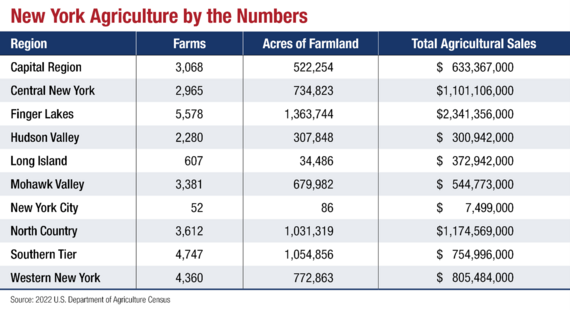The critical role farms play in New York cannot be overstated, both as an economic engine for their communities and an essential part of our food supply system. They employ thousands of people and contributed $2.7 billion to the state’s gross domestic product in 2022. Access to fresh, healthy food also adds to the quality of life in the state, but this local food supply was put to the test during the pandemic, and there are ongoing threats to this industry as outlined in a new report released today by New York State Comptroller Thomas P. DiNapoli.
“New York’s diverse farms are an essential part of the state’s economy, but there are increasing challenges that are changing the agricultural landscape,” said DiNapoli. “Volatile commodity prices, labor pressures and extreme weather are adding to the unpredictability of farming that is contributing to the consolidation and the loss of farms. Policymakers must consider the ways in which state programs and policies affect this sector.”
The new report analyzed recent economic and industry data, including the 2022 United States Department of Agriculture Census released this year. It provides a comprehensive breakdown of farming across upstate New York along with Long Island and New York City. The report includes an analysis of state programs and tax benefits for farmers.
Among the Findings:
- New York has several agricultural products ranked in the top 3 nationwide, including beets, apples, maple syrup, cabbage and milk.
- New York farms grossed $8.5 billion in income in 2022, a 47.8% increase from 2017 to 2022.
- Agritourism and recreation in 2022 saw the largest increase in farm-related income, a 78% jump since 2012.
- Research from Cornell University found that farming and related supporting businesses directly supported 163,148 jobs in New York in 2019.
- In 2022, New York’s farms paid a total of $6.2 billion in expenses, an increase of $1.9 billion from 2017. From 2012 to 2022, hired labor expenditures grew by 68%, far surpassing other categories.
- New York provides tax benefits for farms, saving farmers an estimated $254 million in property and income taxes in 2022.
- Despite economic growth, between 2012 and 2022, the state lost close to 14% of its farms and over 9% of farmland. New York is losing farms and land at a faster rate than the U.S. and all neighboring states except Connecticut (farms) and Massachusetts (farmland).
- The overall decline of farmland is troubling, as conversion to other uses, particularly residential, commercial or industrial, may prevent its use for farming in the future. This includes 1,728 acres located in agricultural districts classified as solar electric generation facilities.
While agriculture faces challenges identified in the report, there are opportunities to support the state’s farms. DiNapoli recommends the state:
- Provide additional support for direct to customer or direct to institution marketing, to help farmers increase the share of New York produced food sold in the state.
- Support research and extension services for the development and adoption of climate change resistant crops and measures to mitigate the effects of extreme weather events and hard to predict changes in seasonal weather patterns. While the state has adopted programs to protect farmland, it should continue to evaluate the efficacy of these policies in siting of renewable energy facilities on lands other than productive farmland.
- Promote supportive policies for new farmers that include training programs.

